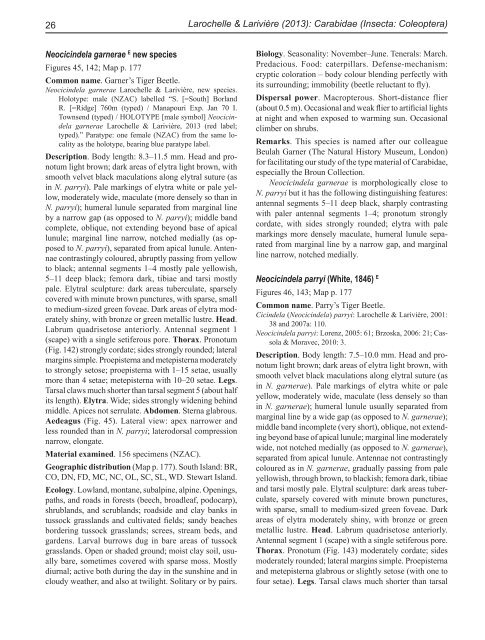Fauna of New Zealand 69 - Landcare Research
Fauna of New Zealand 69 - Landcare Research
Fauna of New Zealand 69 - Landcare Research
Create successful ePaper yourself
Turn your PDF publications into a flip-book with our unique Google optimized e-Paper software.
26<br />
Neocicindela garnerae E new species<br />
Figures 45, 142; Map p. 177<br />
Common name. Garner’s Tiger Beetle.<br />
Neocicindela garnerae Larochelle & Larivière, new species.<br />
Holotype: male (NZAC) labelled “S. [=South] Borland<br />
R. [=Ridge] 760m (typed) / Manapouri Exp. Jan 70 I.<br />
Townsend (typed) / HOLOTYPE [male symbol] Neocicindela<br />
garnerae Larochelle & Larivière, 2013 (red label;<br />
typed).” Paratype: one female (NZAC) from the same locality<br />
as the holotype, bearing blue paratype label.<br />
Description. Body length: 8.3–11.5 mm. Head and pronotum<br />
light brown; dark areas <strong>of</strong> elytra light brown, with<br />
smooth velvet black maculations along elytral suture (as<br />
in N. parryi). Pale markings <strong>of</strong> elytra white or pale yellow,<br />
moderately wide, maculate (more densely so than in<br />
N. parryi); humeral lunule separated from marginal line<br />
by a narrow gap (as opposed to N. parryi); middle band<br />
complete, oblique, not extending beyond base <strong>of</strong> apical<br />
lunule; marginal line narrow, notched medially (as opposed<br />
to N. parryi), separated from apical lunule. Antennae<br />
contrastingly coloured, abruptly passing from yellow<br />
to black; antennal segments 1–4 mostly pale yellowish,<br />
5–11 deep black; femora dark, tibiae and tarsi mostly<br />
pale. Elytral sculpture: dark areas tuberculate, sparsely<br />
covered with minute brown punctures, with sparse, small<br />
to medium-sized green foveae. Dark areas <strong>of</strong> elytra moderately<br />
shiny, with bronze or green metallic lustre. Head.<br />
Labrum quadrisetose anteriorly. Antennal segment 1<br />
(scape) with a single setiferous pore. Thorax. Pronotum<br />
(Fig. 142) strongly cordate; sides strongly rounded; lateral<br />
margins simple. Proepisterna and metepisterna moderately<br />
to strongly setose; proepisterna with 1–15 setae, usually<br />
more than 4 setae; metepisterna with 10–20 setae. Legs.<br />
Tarsal claws much shorter than tarsal segment 5 (about half<br />
its length). Elytra. Wide; sides strongly widening behind<br />
middle. Apices not serrulate. Abdomen. Sterna glabrous.<br />
Aedeagus (Fig. 45). Lateral view: apex narrower and<br />
less rounded than in N. parryi; laterodorsal compression<br />
narrow, elongate.<br />
Material examined. 156 specimens (NZAC).<br />
Geographic distribution (Map p. 177). South Island: BR,<br />
CO, DN, FD, MC, NC, OL, SC, SL, WD. Stewart Island.<br />
Ecology. Lowland, montane, subalpine, alpine. Openings,<br />
paths, and roads in forests (beech, broadleaf, podocarp),<br />
shrublands, and scrublands; roadside and clay banks in<br />
tussock grasslands and cultivated fields; sandy beaches<br />
bordering tussock grasslands; screes, stream beds, and<br />
gardens. Larval burrows dug in bare areas <strong>of</strong> tussock<br />
grasslands. Open or shaded ground; moist clay soil, usually<br />
bare, sometimes covered with sparse moss. Mostly<br />
diurnal; active both during the day in the sunshine and in<br />
cloudy weather, and also at twilight. Solitary or by pairs.<br />
Larochelle & Larivière (2013): Carabidae (Insecta: Coleoptera)<br />
Biology. Seasonality: November–June. Tenerals: March.<br />
Predacious. Food: caterpillars. Defense-mechanism:<br />
cryptic coloration – body colour blending perfectly with<br />
its surrounding; immobility (beetle reluctant to fly).<br />
Dispersal power. Macropterous. Short-distance flier<br />
(about 0.5 m). Occasional and weak flier to artificial lights<br />
at night and when exposed to warming sun. Occasional<br />
climber on shrubs.<br />
Remarks. This species is named after our colleague<br />
Beulah Garner (The Natural History Museum, London)<br />
for facilitating our study <strong>of</strong> the type material <strong>of</strong> Carabidae,<br />
especially the Broun Collection.<br />
Neocicindela garnerae is morphologically close to<br />
N. parryi but it has the following distinguishing features:<br />
antennal segments 5–11 deep black, sharply contrasting<br />
with paler antennal segments 1–4; pronotum strongly<br />
cordate, with sides strongly rounded; elytra with pale<br />
markings more densely maculate, humeral lunule separated<br />
from marginal line by a narrow gap, and marginal<br />
line narrow, notched medially.<br />
Neocicindela parryi (White, 1846) E<br />
Figures 46, 143; Map p. 177<br />
Common name. Parry’s Tiger Beetle.<br />
Cicindela (Neocicindela) parryi: Larochelle & Larivière, 2001:<br />
38 and 2007a: 110.<br />
Neocicindela parryi: Lorenz, 2005: 61; Brzoska, 2006: 21; Cassola<br />
& Moravec, 2010: 3.<br />
Description. Body length: 7.5–10.0 mm. Head and pronotum<br />
light brown; dark areas <strong>of</strong> elytra light brown, with<br />
smooth velvet black maculations along elytral suture (as<br />
in N. garnerae). Pale markings <strong>of</strong> elytra white or pale<br />
yellow, moderately wide, maculate (less densely so than<br />
in N. garnerae); humeral lunule usually separated from<br />
marginal line by a wide gap (as opposed to N. garnerae);<br />
middle band incomplete (very short), oblique, not extending<br />
beyond base <strong>of</strong> apical lunule; marginal line moderately<br />
wide, not notched medially (as opposed to N. garnerae),<br />
separated from apical lunule. Antennae not contrastingly<br />
coloured as in N. garnerae, gradually passing from pale<br />
yellowish, through brown, to blackish; femora dark, tibiae<br />
and tarsi mostly pale. Elytral sculpture: dark areas tuberculate,<br />
sparsely covered with minute brown punctures,<br />
with sparse, small to medium-sized green foveae. Dark<br />
areas <strong>of</strong> elytra moderately shiny, with bronze or green<br />
metallic lustre. Head. Labrum quadrisetose anteriorly.<br />
Antennal segment 1 (scape) with a single setiferous pore.<br />
Thorax. Pronotum (Fig. 143) moderately cordate; sides<br />
moderately rounded; lateral margins simple. Proepisterna<br />
and metepisterna glabrous or slightly setose (with one to<br />
four setae). Legs. Tarsal claws much shorter than tarsal
















